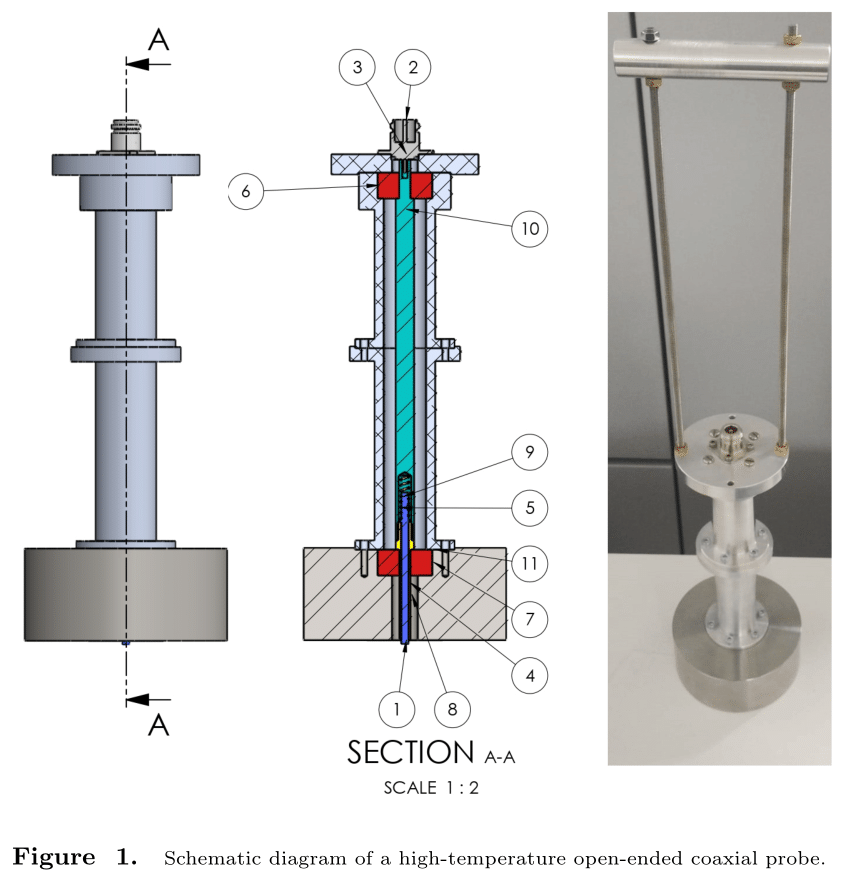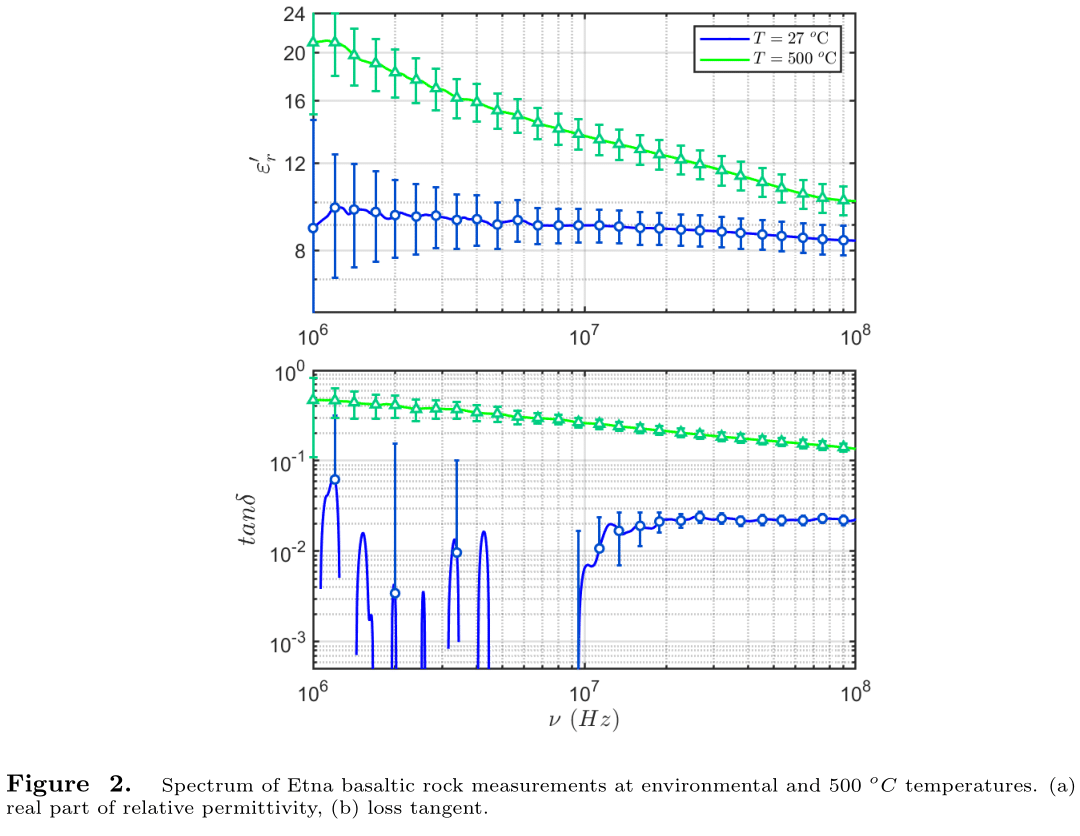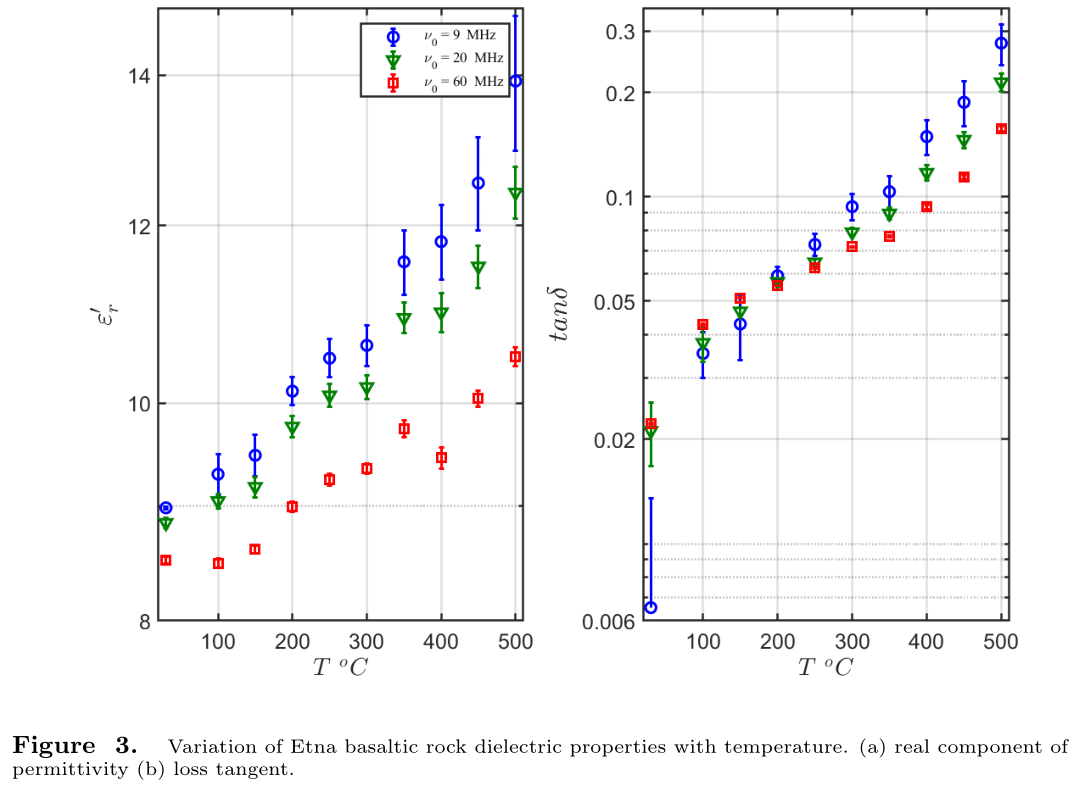- 1Dipartimento di Matematica e Fisica, Università degli studi Roma Tre, 00146 Rome, Italy
- 2Istituto di Astrofisica e Planetologia Spaziali di Roma, (INAF/IAPS), 00133 Rome, Italy
Abstract
A new set-up of open-ended coaxial line based on the capacitive-load model is developed to measure dielectric properties of materials at elevated temperatures up to 500 oC over the frequency range of 1 - 100 MHz. The complex reflection coefficients are measured by a Vector Network Analyzer and are translated to the complex permittivity of the material under test using transmission line theory. Measurements are conducted on a basaltic rock sample that can be considered a Venusian analog.
INTRODUCTION
Analysis of dielectric behavior of planetary crusts-rock analogs at planetary ambient conditions is critical to determine their impact on the propagating electromagnetic waves. A variety of measurements have been made on planetary analogs and samples at low temperatures like temperatures at Mars, Moon. However, very little is known about the dielectric properties of rocks and minerals for planetary analog materials at radar frequencies and elevated temperatures. While, for example, Envision the upcoming ESA mission (Thakur et al., 2023), aiming to study the Venus subsurface, needs measurements on some analogs at 9 MHz operating frequency and at Venusian rocks temperature that reaches to ∼500 oC.
The reflection type of the transmission line method is based on the reflection of incident electromagnetic waves from the media interface that is caused by impedance discontinuity at two sides of the interface (e.g., Von Hippel, 1954; Orfanidis, 2002).
In this study, a new set-up is developed based on (Gershon et al., 1999) open-ended coaxial probe (a truncated transmission line) to measure the complex relative dielectric permittivity materials using the capacitive model.
THEORY
In a coaxial line electric fields are in the radial direction between the inner and outer conductor, and magnetic fields form circles around the inner conductor. The 1-port network analyzer measures the reflection coefficient, S11, that is related to the input impedance at the probe. For a coaxial line of length d that ends with a load impedance ZL, the probe input impedance seen looking toward the load is expressed as (Orfanidis, 2002):
where Zc is the characteristic impedance of the transmission line, and k is the complex propagation constant of the electromagnetic wave. For a short-circuited transmission line ZL =∞, hence the load admittance can be obtained by:
where Zin and Zsh are the input impedance of the probe and short-circuited line. For differing impedances at two sides of the interface, there will be a reflection when an electromagnetic wave propagates through the interface. A commonly used technique to compute the complex permittivity of a medium is based on measuring the reflection coefficient using a network analyzer. When the open end of the coaxial line probe is connected to a sample, the capacitive model configuration of open-ended coaxial line in the reflection method can be used to characterize the dielectric properties of the material. In terms of a capacitive model, the complex relative permittivity of the sample will be
where ω is angular frequency, and C0 is the probe capacitance. Using a reference material with the known permittivity (e.g., air with εrref = 1) the reference admittance of YrefL is computed from the corresponding measured reflection coefficients.
Experimental Procedure
Figure 1 displays a schematic diagram of the probe and the probe that has been made. The reflection coefficients are measured using an Agilent E5071C Programmable Vector Network Analyzer (VNA) over the frequency range of 1-100 MHz with log frequency sweep and 1601 frequency points. Before the measurement, a preliminary calibration is performed to correct the effects of coaxial cable, connectors, adaptor, and VNA systematic errors. A sample (a basaltic rock sample collected from Mount Etna volcano on the east coast of Sicily, Italy) is placed in an insulated Nabertherm furnace, and measurements are acquired at temperatures in the range of 100-500 oC with an interval of 50 oC. This sample can be considered as a dry Venusian analog mineral in the Venusian environment.

Figure 2 presents the spectrum of the real part of permittivity and loss tangent computed from the measured reflection coefficient at different temperatures. At room temperature, the ε′r is almost constant, however, by increasing temperature the dispersion effects become significant. In addition, the calculated tanδ at T = 27 oC presents a constant value of ∼0.02 at frequencies above 15 MHz. At lower frequencies, some instabilities appear that are related to the instrument’s limitations.

Dielectric properties of Etna basaltic rock at temperatures from 27 oC to 500 oC and for nominal operating frequencies of ν= 9, 20, and 60 MHz with a 5 MHz bandwidth, are shown in Figure 3. The results show an increase in relative permittivity and loss tangent as frequency decreases and temperature increases. The loss tangent values are strongly influenced by temperature and are almost one order of magnitude larger at 500 oC than those at 27 oC.

Conclusion
Dielectric properties of a basaltic rock sample were determined by measuring the reflection coefficients over the temperature range 27 oC to 500 oC. An increase in the real component of relative permittivity and loss tangent was observed with temperature, which is higher at low frequencies. In addition, sample complex permittivity shows a temperature-dependent dispersion. This method can be used particularly for Venusian crust analogs. The results are critical to configuring the radar system.
References
Gershon, D. L., Calame, J., Carmel, Y., Antonsen, T., & Hutcheon, R. M. (1999). Open-ended coaxial probe for high-temperature and broad-band dielectric measurements. IEEE transactions on microwave theory and techniques, 47 (9), 1640–1648.
Orfanidis, S. J. (2002). Electromagnetic waves and antennas.
Thakur, S., Sbalchiero, E., & Bruzzone, L. (2023). Exploring Venus subsurface: Analysis of geological targets and their properties. Planetary and Space Science, 225 , 105620.
Von Hippel, A. R. (1954). Dialectics and waves. John Wiley and Sons.
How to cite: Baniamerian, J., Emanuel Lauro, S., Cosciotti, B., Brin, A., Lefevre, C., Pettinelli, E., and Mattei, E.: An experimental set-up for dielectric characterization of Venusian crust analogs at high temperatures, Europlanet Science Congress 2024, Berlin, Germany, 8–13 Sep 2024, EPSC2024-4, https://doi.org/10.5194/epsc2024-4, 2024.